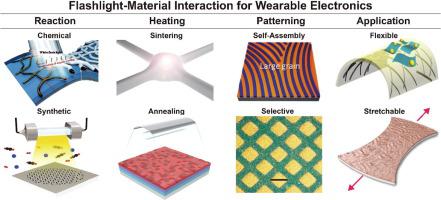当前位置:
X-MOL 学术
›
Mater. Today
›
论文详情
Our official English website, www.x-mol.net, welcomes your
feedback! (Note: you will need to create a separate account there.)
Flashlight-material interaction for wearable and flexible electronics
Materials Today ( IF 21.1 ) Pub Date : 2021-09-03 , DOI: 10.1016/j.mattod.2021.07.027 Tae Hong Im 1 , Jae Hee Lee 1 , Hee Seung Wang 1 , Sang Hyun Sung 1 , Young Bin Kim 1 , Yoonsoo Rho 2 , Costas P. Grigoropoulos 2 , Jung Hwan Park 3 , Keon Jae Lee 1
Materials Today ( IF 21.1 ) Pub Date : 2021-09-03 , DOI: 10.1016/j.mattod.2021.07.027 Tae Hong Im 1 , Jae Hee Lee 1 , Hee Seung Wang 1 , Sang Hyun Sung 1 , Young Bin Kim 1 , Yoonsoo Rho 2 , Costas P. Grigoropoulos 2 , Jung Hwan Park 3 , Keon Jae Lee 1
Affiliation

|
Light-material interaction has received significant attention for wearable electronics because of its exceptional ability to excite multi-physical, transient, and non-equilibrium photon interactions in a spatiotemporally controlled manner. It has realized unique photothermal and photochemical reactions with various types of materials, including metal nanomaterials, ceramics, graphene, polymers, and perovskites, enabling the substantial performance improvement of soft electronics without damaging a temperature-sensitive substrates. Among the numerous optical sources, flash lamps have been considered to be a suitable platform for commercial applications owing to their excellent light-output efficiency, rapid processing capability, and outstanding compatibility with large-scale roll-to-roll manufacturing. These exclusive features offer considerable advantages in a broad range of wearable and flexible electronics such as solar cells, thin-film-transistors, optoelectronics, and sensors on polymer substrates compared to the conventional high-temperature microfabrication processes. The flash lamp technology has consistently advanced to provide novel concepts of nanomaterials/devices with unlimited form factors and strategies for future wearable electronics. Here, the recent progress in the field of flashlight-material interaction for soft electronics is summarized with regard to the process parameters, materials, and devices, together with the latest updates on the flash lamp technology.
中文翻译:

用于可穿戴和柔性电子产品的手电筒-材料交互
光与材料的相互作用因其以时空控制的方式激发多物理、瞬态和非平衡光子相互作用的卓越能力而受到可穿戴电子产品的广泛关注。它与各种类型的材料(包括金属纳米材料、陶瓷、石墨烯、聚合物和钙钛矿)实现了独特的光热和光化学反应,从而在不损坏温度敏感基板的情况下大幅提高软电子器件的性能。在众多光源中,闪光灯因其出色的光输出效率、快速处理能力以及与大规模卷对卷制造的出色兼容性而被认为是商业应用的合适平台。与传统的高温微加工工艺相比,这些独特的功能为各种可穿戴和柔性电子产品(例如太阳能电池、薄膜晶体管、光电子产品和聚合物基板上的传感器)提供了相当大的优势。闪光灯技术不断进步,为未来可穿戴电子产品提供了具有无限外形尺寸和策略的纳米材料/设备的新颖概念。本文从工艺参数、材料和器件方面总结了软电子闪光灯-材料相互作用领域的最新进展,以及闪光灯技术的最新进展。
更新日期:2021-09-03
中文翻译:

用于可穿戴和柔性电子产品的手电筒-材料交互
光与材料的相互作用因其以时空控制的方式激发多物理、瞬态和非平衡光子相互作用的卓越能力而受到可穿戴电子产品的广泛关注。它与各种类型的材料(包括金属纳米材料、陶瓷、石墨烯、聚合物和钙钛矿)实现了独特的光热和光化学反应,从而在不损坏温度敏感基板的情况下大幅提高软电子器件的性能。在众多光源中,闪光灯因其出色的光输出效率、快速处理能力以及与大规模卷对卷制造的出色兼容性而被认为是商业应用的合适平台。与传统的高温微加工工艺相比,这些独特的功能为各种可穿戴和柔性电子产品(例如太阳能电池、薄膜晶体管、光电子产品和聚合物基板上的传感器)提供了相当大的优势。闪光灯技术不断进步,为未来可穿戴电子产品提供了具有无限外形尺寸和策略的纳米材料/设备的新颖概念。本文从工艺参数、材料和器件方面总结了软电子闪光灯-材料相互作用领域的最新进展,以及闪光灯技术的最新进展。











































 京公网安备 11010802027423号
京公网安备 11010802027423号